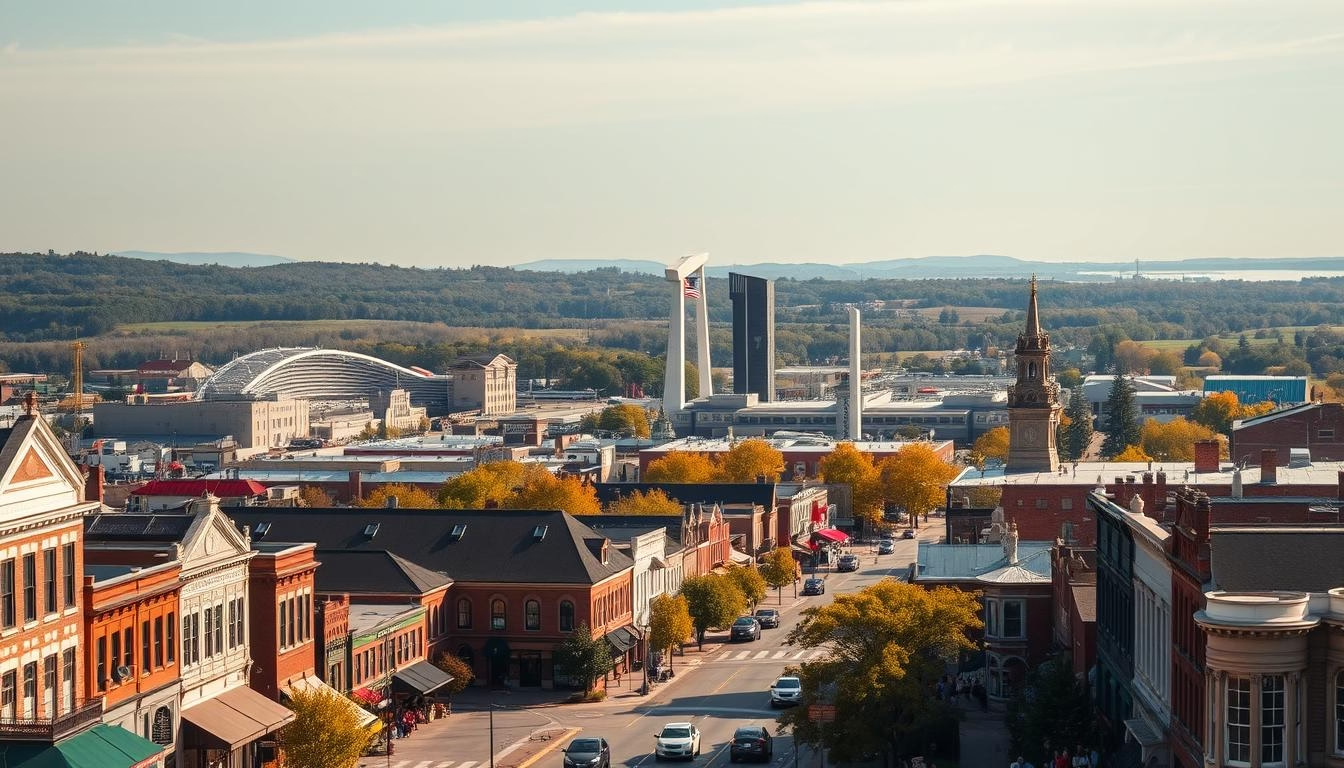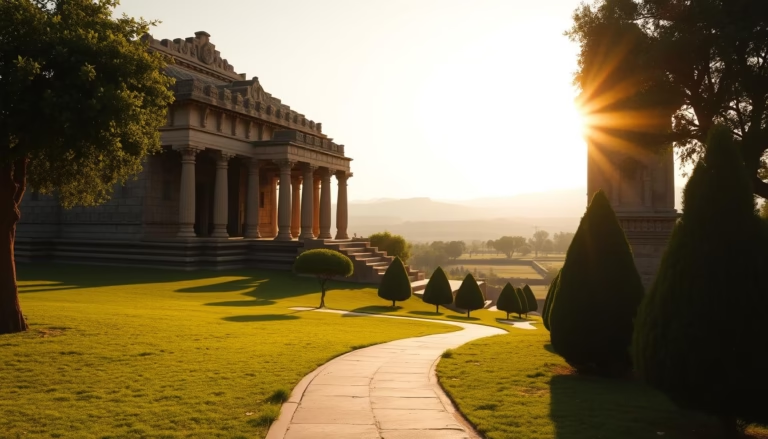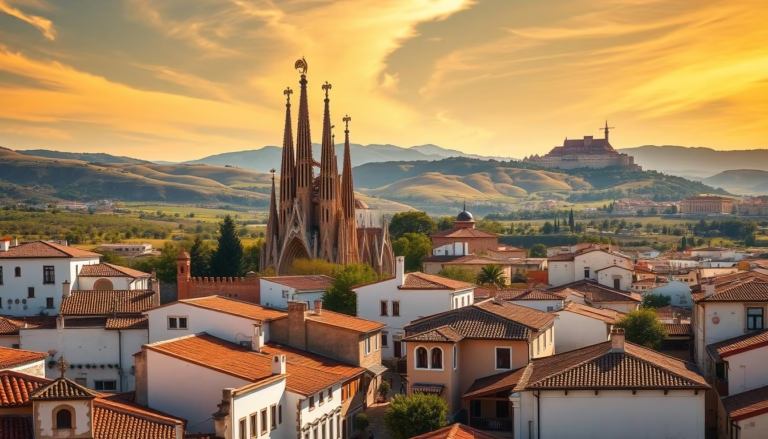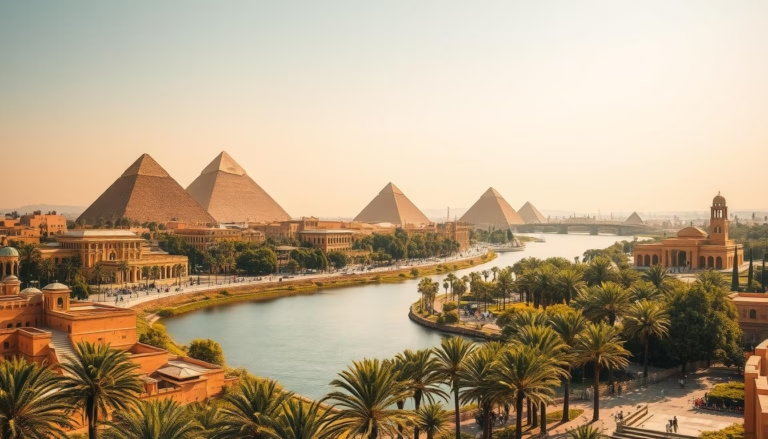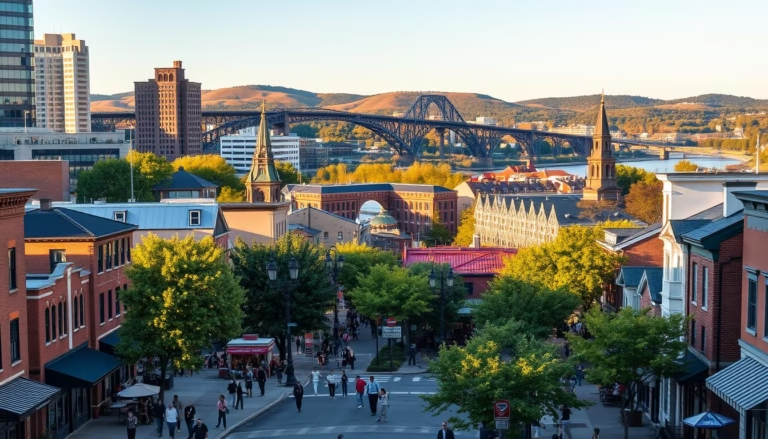Explore the Best Indiana Cities to Call Home and Visit
Did you know Indiana offers over 600 communities to call home—more than the number of towns in most neighboring states? This Midwestern gem combines affordability with diverse lifestyles, boasting an average household income of $66,713 and property taxes nearly 20% lower than the national median.
The Hoosier State surprises visitors with its contrasts. Urban centers like Indianapolis buzz with cultural events and job opportunities, while quiet towns preserve historic charm. Over 6.8 million residents enjoy this balance—7% sales tax keeps daily costs manageable, and a 3.23% income tax rate leaves more money in pockets.
What makes these locations stand out? From walkable neighborhoods with top-rated schools to agricultural areas offering spacious living, Indiana’s variety caters to all life stages. Young professionals find thriving tech hubs, while retirees appreciate peaceful lakeside communities.
Key Takeaways
- Indiana hosts 600+ unique communities with distinct personalities
- Combined tax rates rank among the nation’s most budget-friendly
- 7% sales tax supports affordable everyday purchases
- Urban and rural areas offer contrasting lifestyle benefits
- Family-friendly neighborhoods often feature exceptional school systems
- Multiple regions show strong job market growth
Introduction: Discover Indiana’s Unique Culture
Imagine sipping sweet tea on a historic courthouse square while jazz musicians play nearby. This scene captures Indiana’s magic – a state where tradition and innovation coexist seamlessly. Communities here celebrate their roots through architecture, local cuisine, and shared stories passed down through generations.
Heartland Hospitality Meets Modern Flair
Neighbors still borrow sugar here, but you’ll also find cutting-edge tech startups and farm-to-table restaurants. Annual events like the Indy Fringe Festival and Covered Bridge Celebration showcase this blend. Over 85% of residents report knowing their local shop owners by name.
More Than Cornfields and Basketball
While agriculture remains vital, Indiana’s cultural landscape surprises newcomers. The state houses:
- 31 professional theater companies
- 4 UNESCO Creative Cities
- 19 historic national landmarks
Affordable housing allows residents to enjoy these amenities without financial strain. A family of four spends 18% less here than the national average on entertainment and dining.
This great place to put down roots offers something rare – authentic connections. Whether attending a county fair or gallery opening, you’ll find welcoming faces ready to share what makes their corner of the state special.
Best Cities in Indiana to Live and Visit
With 117 distinct municipalities and 450 towns, the Hoosier State presents endless possibilities for establishing roots. Median home values range from $145,000 in growing suburbs to $350,000 in historic districts, offering options for various budgets. Seventeen standout locations particularly shine for their balance of affordability and lifestyle perks.
Urban Energy Meets Small-Town Charm
Metropolitan areas buzz with pro sports stadiums and tech campuses employing over 12% of the workforce. Meanwhile, tight-knit towns host weekly farmers markets and festivals celebrating local heritage. Walkability scores vary dramatically – from 90 in downtown neighborhoods to 15 in rural areas.
Prioritizing What Matters Most
Smart relocation decisions start by evaluating:
- Commute times to major employers
- School district ratings (30% exceed state averages)
- Access to parks and recreation facilities
- Property tax rates (average 0.87% vs national 1.08%)
Young professionals often lean toward loft apartments near innovation hubs, while families favor communities with top-ranked STEM programs. Retirees appreciate lakefront properties with low-maintenance yards. Whatever your home criteria, Indiana delivers quality options without coastal price tags.
Vibrant Urban Centers and Cultural Hubs
From skyline views to community festivals, Indiana’s metropolitan areas blend modern energy with Midwestern warmth. These thriving urban hubs showcase world-class amenities while maintaining neighborly charm through local traditions.
Spotlight on Indianapolis and Fort Wayne
With median home prices hovering near $232,000, Indianapolis makes urban living accessible. The city dazzles with 10,000+ acres of green spaces like White River State Park, where kayakers paddle past downtown skyscrapers. Sports fans rally behind the Colts and Pacers, filling Lucas Oil Stadium with roaring crowds.
Fort Wayne balances affordability and growth, offering 86 parks within city limits. Residents enjoy outdoor concerts at Headwaters Park and innovative dining along The Landing district. Both urban centers maintain walkable downtown cores where historic theaters sit beside craft breweries.
The Role of Art, Sports, and Local Events
Cultural calendars stay packed with can’t-miss activities. Indianapolis hosts the nation’s largest single-day sporting event (the Indy 500) alongside monthly gallery walks. Fort Wayne’s vibrant arts scene includes the Castle Gallery and three professional theater companies.
Annual festivals like Indy Jazz Fest and Middle Waves Music Festival transform downtown streets into communal dance floors. These events don’t just entertain – they create shared memories that strengthen neighborhood bonds across generations.
Suburban Life and Family-Friendly Communities
Families seeking spacious living and strong community ties find their perfect match in Indiana’s suburban landscapes. These areas blend quiet streets with convenient access to urban jobs, creating environments where children flourish and neighbors become lifelong friends.
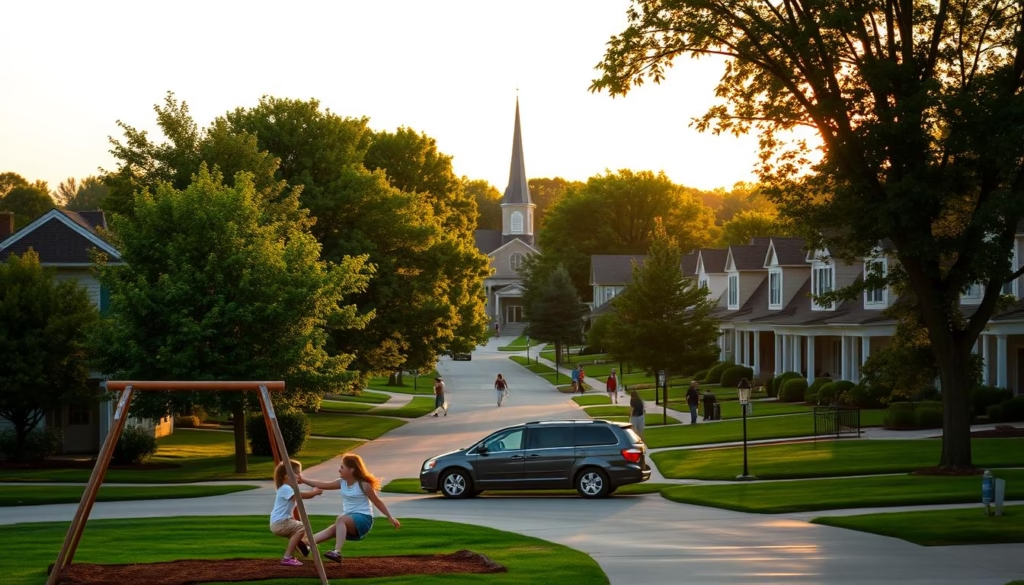
Great Suburbs With Excellent Schools
Carmel stands out with its top-ranked education system, serving nearly 98,000 residents. The city’s schools consistently achieve SAT scores 15% above state averages, supported by a median household income of $167,227. Over 1,600 acres of parks give families room to explore nature trails and playgrounds.
Just south, Fishers offers more affordable home options at $385,000 median prices. The Hamilton Southeastern School District here produces National Merit Scholars annually. “Our teachers know every student’s name,” says a local parent council member, highlighting the personalized approach.
Neighborhood Amenities and Lifestyle Benefits
These suburb areas prioritize family needs through thoughtful planning. Carmel’s Arts & Design District hosts free summer concerts, while Fishers’ Nickel Plate District amphitheater draws crowds for outdoor movies. Both communities feature:
- Community centers with indoor pools
- Networked bike paths connecting schools
- Weekly farmers markets
Safety remains a key focus, with neighborhood watch programs active in 92% of subdivisions. The area combines recreational spaces with practical conveniences – grocery stores sit within 1.5 miles of most homes, and commuters reach Indianapolis in 25 minutes.
Young families particularly appreciate the balance of education quality and lifestyle perks. From soccer leagues to robotics clubs, these suburbs nurture children’s growth while giving parents opportunities to connect through volunteer programs and social groups.
Affordable Living and Cost Considerations
Stretching your dollar further becomes reality in Indiana’s welcoming communities. Smart financial planning meets practical living through competitive property rates and diverse housing options. Let’s explore how these economic advantages create stability for households at every income level.
Comparing Median Home Prices and Property Taxes
Indiana’s average annual property tax of $1,102 lets homeowners reinvest savings into family priorities. Four standout locations demonstrate this value:
| City | Median Home Price | Median Income | Annual Property Tax |
|---|---|---|---|
| Anderson | $117,500 | $37,110 | $980 |
| Muncie | $130,400 | $34,602 | $1,021 |
| Terre Haute | $136,000 | $37,299 | $1,095 |
| Hammond | $156,800 | $46,974 | $1,240 |
Budget-Friendly Cities and Cost Insights
Anderson’s housing costs sit 19% below state averages, freeing funds for education or leisure. Muncie couples affordable utilities with 15% cheaper groceries than coastal cities. “Our mortgage payment equals what friends pay in rent elsewhere,” shares a Terre Haute teacher.
These communities prove low costs don’t mean limited opportunities. Hammond residents enjoy 87% employment rates while maintaining below-average living expenses. Healthcare premiums here run 22% lower than national figures, according to recent surveys.
“We saved enough for a college fund just by moving from Chicago to Hammond.”
Quality Education and Career Opportunities
Indiana’s classrooms and boardrooms share an important connection. The state’s education system fuels workforce development through innovative programs and partnerships. This synergy creates pathways for students to transition smoothly into growing industries.
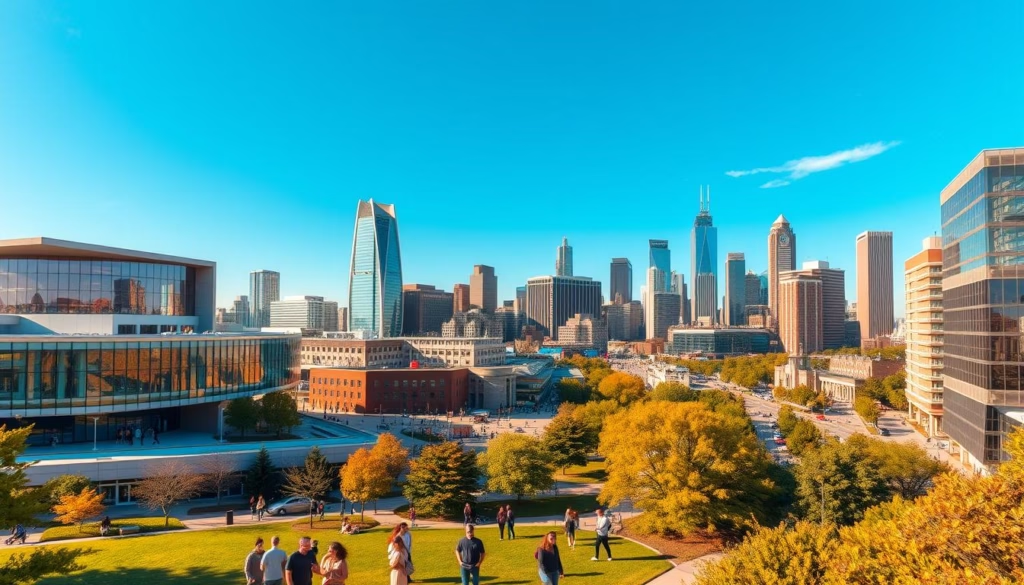
Noteworthy Schools and Universities
From South Bend to Evansville, prestigious institutions shape tomorrow’s leaders. The University of Notre Dame’s research initiatives attract $200 million in annual funding. Purdue University’s engineering grads earn starting salaries 18% above national averages.
Other standout schools include:
- Indiana University’s Kelley School of Business (#1 ranked online MBA)
- Ball State’s immersive learning projects with 650+ community partners
- University of Southern Indiana’s nursing program (94% licensure pass rate)
Local Industries and Job Market Trends
Major employers actively recruit from these Indiana University campuses and technical colleges. Healthcare roles will grow 14% by 2030, while advanced manufacturing needs 35,000 new workers. The average household income rose 8% since 2020 in tech hubs like Indianapolis.
“My Purdue degree opened doors at three Fortune 500 companies,” shares robotics engineer Marco T. This career momentum stems from employer-educator collaborations in fields like:
- Pharmaceutical research (Eli Lilly)
- Sustainable energy (Cummins)
- Agricultural technology (Corteva)
Continuing education programs help workers adapt to market changes. Community colleges offer affordable certifications in high-demand areas, ensuring all residents can access opportunities.
Outdoor Recreation and Natural Attractions
Indiana’s lush landscapes offer more than scenic views—they provide spaces where daily stress fades and connections grow. From urban greenways to ancient forests, these natural treasures invite exploration and rejuvenation.
Parks, Trails, and Nature Preserves Across the State
White River State Park brings wilderness to Indianapolis’ doorstep, while Fort Wayne’s 100+ green spaces prove nature thrives in urban areas. Evansville’s Wesselman Woods shelters 200-acre old-growth forest—a rare Midwest gem. Adventurers find dramatic dunes near South Bend at Indiana Dunes National Park, where Lake Michigan’s waves sculpt sandy peaks.
State forests like Yellowwood and Morgan-Monroe offer secluded trails through rolling hills. These parks serve as living classrooms where families learn ecology and history through interactive exhibits.
Nature’s Impact on Daily Living
Outdoor activities boost physical health and mental clarity. Morning jogs along Beanblossom Bottoms’ boardwalks or sunset kayak trips create natural stress relief. Communities bond over weekend hiking groups and youth nature programs.
Regular park visits correlate with 22% higher life satisfaction in local surveys. “Our family reconnects here without screens,” shares a Terre Haute parent. These spaces remind us that quality life often begins where pavement ends.
